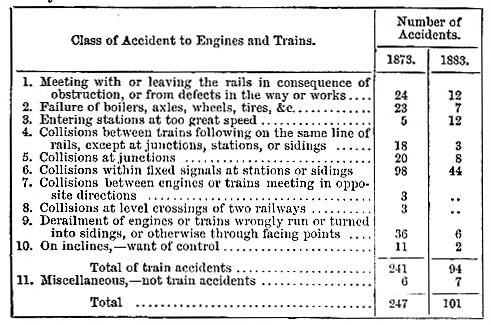1902 Encyclopedia > Railway, Railways (Railroad) > Railway Accidents
Railway, Railways
(Part 42)
I. RAILWAY ACCIDENTS
Railway Accidents
Accidents on railways arise from three causes,—inattention of servants, defective material either in the works or the rolling stock, and excessive speed. But the adoption of the absolute block system, with the use of interlocked points and signals and continuous brakes, has led to an absolute diminution of the number of accidents, whilst the amount of traffic has been greatly increased. In 1883 the total number of train accidents on railways in the United Kingdom, reported on to the Board of Trade, was 94 on 18,681 miles open, against 241 accidents ten years earlier on 16,082 miles open. The increased efficiency of management is strikingly brought out by Table XXXII.:—

During the period 1873-1883 there was therefore a material improvement not only in the character of the way and works but also in that of the rolling stock. Accidents from entering stations at too great a speed have been augmented in number,—a result naturally arising from the greater speeds and volumes of traffic. Ten of these (for 1873 and 1883) were due to want of control of the trains, and seven others to want of continuous brakes. Collisions have been diminished to a marked extent; and nearly all of those in 1883 took place at junctions, stations, and sidings, mostly within fixed signals. Many of these collisions could have been obviated if proper interlocking and block working had been in use, together with continuous brakes on the trains. Of the 94 investigated train accidents 75 took place on the lines of fifteen companies, working in the aggregate 12,850 miles, and having run upwards of 216 millions of miles with trains, —showing that one accident happened for every 171 miles of railway, or for every 3 millions nearly of miles run. One person in every 625 employed in the traffic—locomotive, carriage engineer’s, and stores departments—in 1883 was killed in the service. The employés who stand at the extremes of the scale of fatality are guards; of brakemen and goods-guards 1 in 97 lost their lives, and of passenger-guards only 1 in 5902. Pointsmen and signalmen occupy a medium position in the scale, 1 in 800 losing their lives; of engine-drivers 1 in 643 was killed, and of firemen 1 in 533. Of persons other than passengers or servants of railway companies who suffered in accidents, trespassers, including suicides, as usual form the largest number,—354 killed and 165 injured. Of passengers 125 were killed and 1416 were injured — together, 1541 persons, or 1 in about 444,000 of the total number of passengers in 1883.
Read the rest of this article:
Railway, Railways - Table of Contents
|
